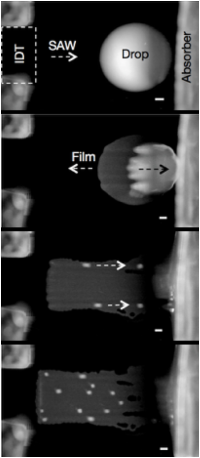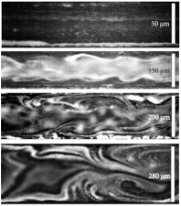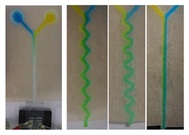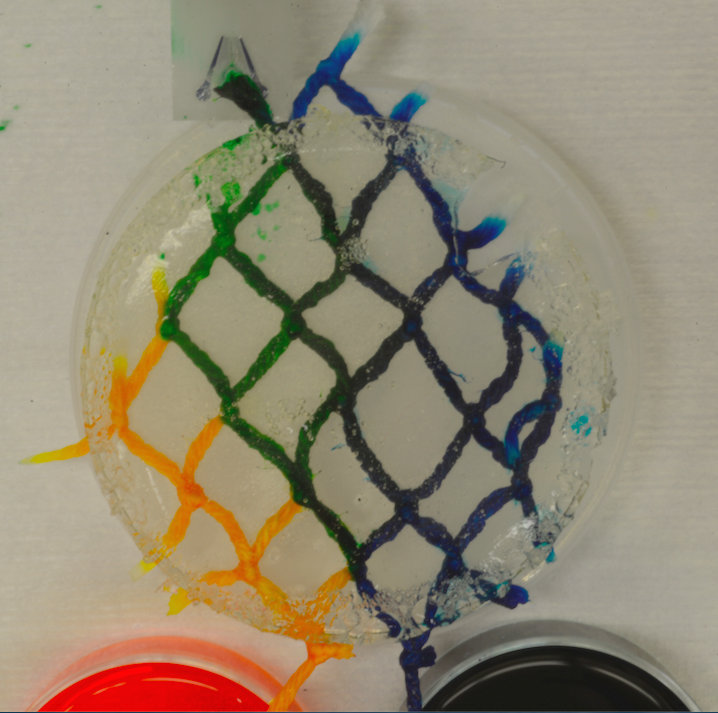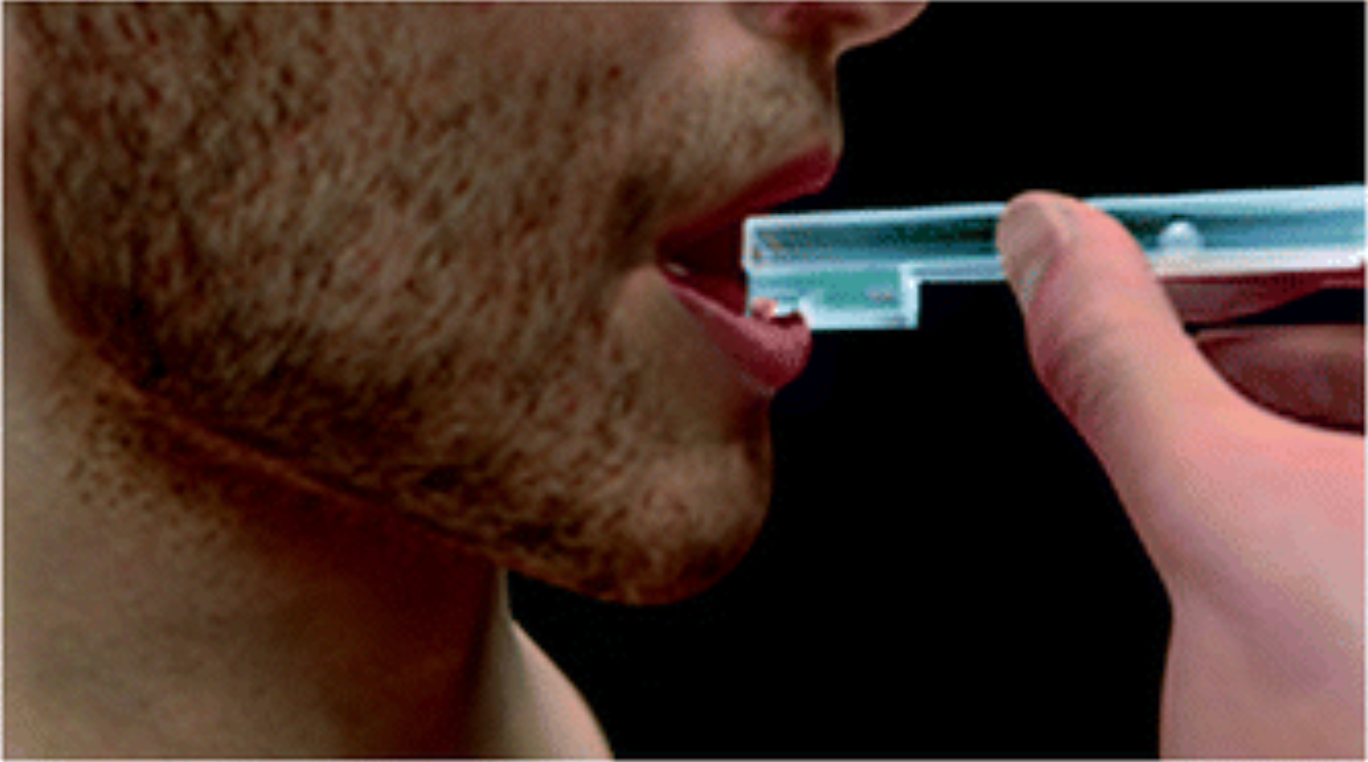Droplet Transport and ManipulationThe leakage of the acoustic energy into the fluid due to the diffraction of the surface acoustic wave (SAW) front as it meets the fluid is responsible for the flow dynamics that arise, known as acoustic streaming. Over length scales much larger than the sound wavelength in the fluid, the viscous dissipation of the sound energy gives rise to a steady momentum flux which drives Eckart streaming. If the transfer of momentum to the interface arising from this together with the acoustic radiation pressure is sufficient to overcome the contact line forces that pin a sessile drop in position, the drop begins to translate. Such translation at linear speeds typically on the order of 1-10 cm/s together with the ability to split and merge them can be used for drop actuation and bioparticle collection and concentration in open (droplet) microfluidic platforms for a variety of applications, such as chip-based polymerase chain reaction, biosensors, etc., in which the drop constitutes a transport vehicle for biological entities. We have also demonstrated this as novel mechanism for driving a drop containing a suspension of cells into a bioscaffold as a means for rapid and efficient bioscaffold cell seeding in tissue or orthopaedic engineering.
|
|
Relevant Publications
- MK Tan, JR Friend, LY Yeo. Microparticle Collection and Concentration via a Miniature Surface Acoustic Wave Device. Lab Chip 7, 618-625 (2007).
- H Li, JR Friend, LY Yeo. A Scaffold Cell Seeding Method Driven by Surface Acoustic Waves. Biomaterials 28, 4098-4104 (2007).
- H Li, J Friend, L Yeo, A Dasvarma, K Traianedes. Effect of Surface Acoustic Waves on the Viability, Proliferation and Differentiation of Primary Osteoblast-Like Cells. Biomicrofluidics 3, 034102 (2009).
- M Bok, H Li, LY Yeo, JR Friend. The Dynamics of Surface Acoustic Wave Driven Scaffold Cell Seeding. Biotechnol Bioeng 103, 387-401 (2009).
- S Collignon, J Friend, L Yeo. Planar Microfluidic Drop Splitting and Merging. Lab Chip 15, 1942–1951 (2015).
- A Sudeepthi, L Yeo, AK Sen. Cassie–Wenzel Wetting Transition on Nanostructured Superhydrophobic Surfaces Induced by Surface Acoustic Waves. Appl Phys Lett 116, 093704 (2020).
- A Sudeepthi, A Nath, L Yeo, A Sen. Coalescence of Droplets in a Microwell Driven by Surface Acoustic Waves. Langmuir 37, 1578−1587 (2021).
|
|
Acoustowetting FilmsThe elliptical retrograde motion of solid elements on the substrate as the SAW traverses underneath the drop also induces a steady drift flow within and at the edge of a submicron thick viscous boundary layer, known as Schlichting and Rayleigh streaming, respectively. Such flows have been observed to give rise to curious phenomena in which a counterpropagating thin film is pulled out from a sessile drop, whose front subsequently suffers from transverse instabilities to give rise to unique fingering patterns akin to, but quite distinct from, the classical viscous fingering instabilities observed in gravitational- and Marangoni-driven spreading films. Above these fingers, solitary wave pulses are seen to grow and translate away in the opposite direction.
Relevant Publications
|
Microchannel and Paper TransportIf a microchannel were laser ablated into the surface acoustic wave substrate, it is possible to drive very fast microchannel pumping, with flow rates around 1-100 μl/min, which is one to two orders of magnitude faster than currently available micropumps. Furthermore, it is possible to tune the sound wavelength in the fluid and the microchannel dimension to provide switchability between uniform through-flow for micropumping and oscillatory flow for micro-mixing within the same channel. We have also shown the possibility of transporting and mixing fluid in paper- and thread-based microfluidic systems. Unlike passive capillary-based transport through the paper or thread network, the SAW-induced actuation allows for faster flow as well as more uniform and precise mixing, in the case of paper networks, and for uniform and dynamically-tunable concentration gradients, in the case of thread networks, which can be embedded into hydrogels and tissue scaffolds to enable three-dimension cell culture. Finally, we also show the ability to enhance liquid and nanoparticle transport through the nanopores that make up the interstitial spaces between layers of two-dimensional flakes such as graphene. Relevant Publications
|
Transport through Cells and Tissues
|
We show that exposure of cells to the high frequency (>10 MHz) sound waves in the form of SAWs enhances the uptake of nanoparticles, molecules and nucleic acids by several-fold, whilst retaining very high viabilities (>97%). This is because the high frequency excitation does not induce pore formation but rather temporarily disrupts the membrane lipid structure, thus increasing its permeability sufficiently to allow efficient transmembrane molecular transport. The effect, is however, transient as the lipid structure immediately returns to its original state when the excitation is relaxed, therefore preserving the cell viability. Moreover, as the internalisation mechanism does not involve endocytosis, we observe the therapeutic cargo to be distributed throughout the cell instead of being localised within the endosomes/lysosomes, thus minimising the possibility for their degradation through the endosomal recycling pathway and thereby facilitating higher probabilities for trafficking them to the nucleus where they can be transfected. Indeed, with siRNA delivery, we observe a two-fold knockdown in the gene expression, therefore highlighting the potential of the platform as a powerful tool for ex vivo autologous therapeutics in which a patient’s target cells are isolated from their blood or tissue, re-engineered in the laboratory and re-infused.
|
In a similar way, direct application of the SAW to tissue is shown to enhance controlled delivery of these therapeutic molecules into the mucosal layer. Such localisation within the mucosa, which is rich in immunocytes, avoids deeper penetration into the vascularised submucosal regions where the drug is mostly taken up by the systemic circulation, and hence is particularly useful as a vaccination strategy since a far stronger local immune response can be elicited compared to systemic vaccination routes. This is validated in a porcine buccal model in which we demonstrate the platform as a practical portable handheld applicator for effective non-invasive vaccination.
Relevant Publications
Relevant Publications
- S Ramesan, AR Rezk, C Dekiwadia, C Cortez-Jugo, LY Yeo. Acoustically-Mediated Intracellular Delivery. Nanoscale 10, 13165–13178 (2018).
- S Ramesan, AR Rezk, LY Yeo. High Frequency Acoustic Permeabilisation of Drugs Through Tissue for Localised Mucosal Delivery. Lab Chip 18, 3272–3284 (2018) [Article coverart selected for journal back cover p 3324].
